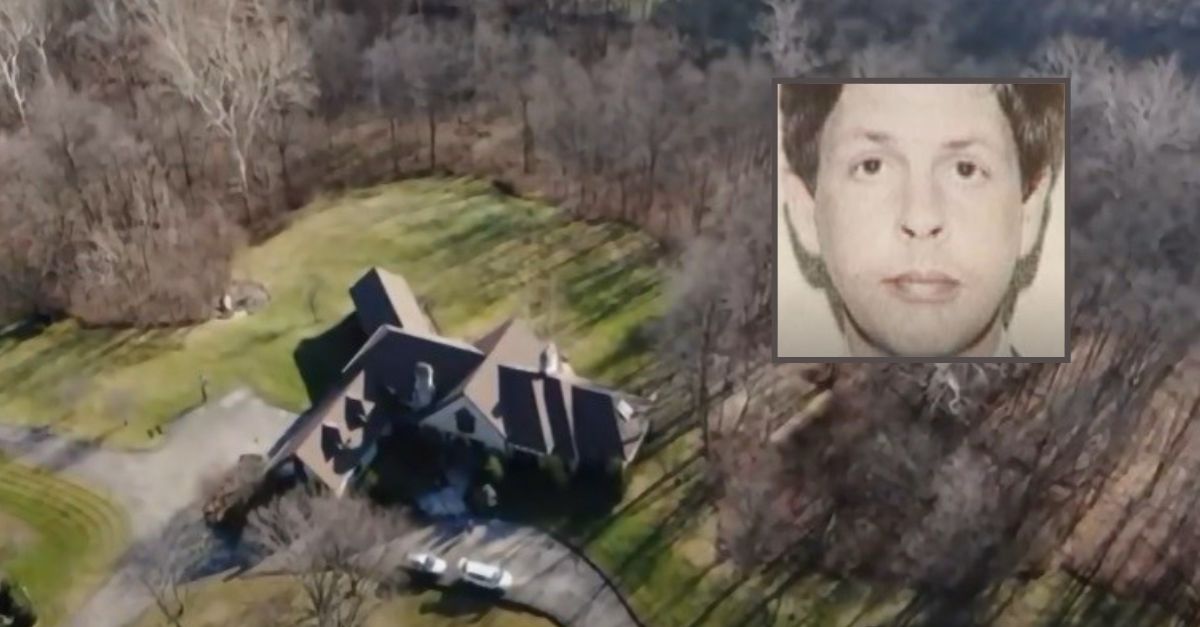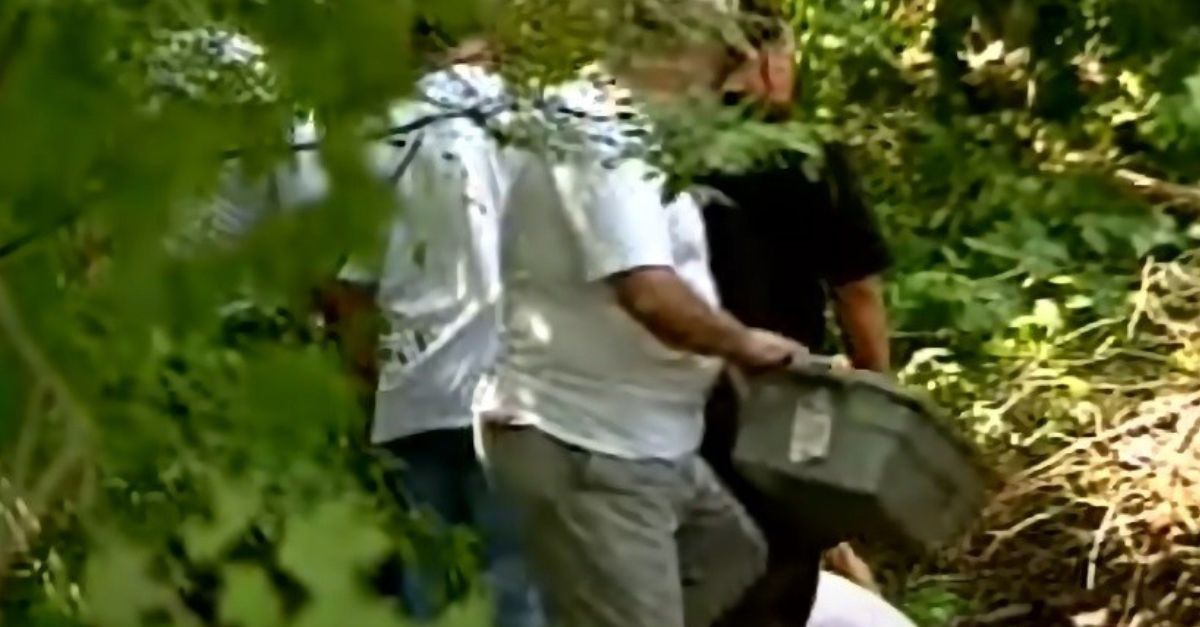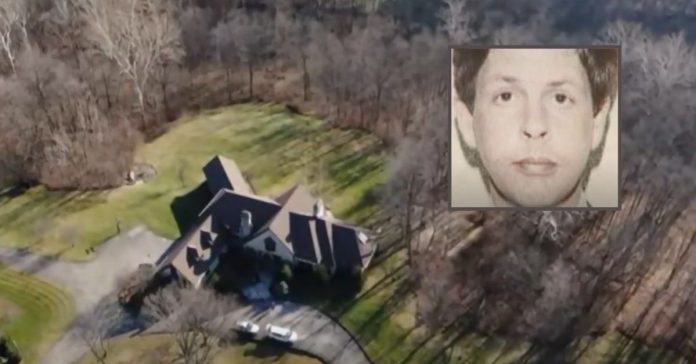
Law enforcement and members of the coroner’s office in Hamilton County, Indiana scoured the 18-acre Fox Hollow Farm in the 1990s searching for human remains. Inset: Herbert Baumeister. (YouTube screengrab/WTHR)
More than 30 years after her son Allen went missing, Sharon Livingston said her mother’s intuition convinced her beyond a shadow of doubt that the remains of her long-missing son would be found on the property of suspected serial killer Herbert Baumeister. This week, that gut feeling was confirmed.
Coroner Jeff Jellison of Hamilton County, Indiana, announced Tuesday that bone fragments belonging to Allen Livingston — a queer man who was just 27 years old when reported missing in 1993 — were among those newly identified out of the some 10,000 human remains investigators have collected over the years from an 18-acre farm in Westfield known as Fox Hollow.
Baumeister killed himself in 1996 shortly after a warrant for his arrest was issued and Indianapolis police had begun questioning him about a string of gay men who went missing from the area during the 1980s and 1990s.
Key to the case was an informant identified as Tony Harris, who claimed that he had met Baumeister at an area gay bar in 1994 and spent a horrifying evening with him at his home. Harris’ friend, Roger Goodlet, had gone missing around that same time and Harris suspected Baumeister may have been responsible. According to an A&E documentary on the case entitled “The Secret Life of Serial Killers,” Harris would later tell police that when he approached Baumeister, Baumeister introduced himself as “Brian Smart” and had spent a good chunk of the evening staring at Goodlet’s missing poster hanging in the bar.
When Baumeister — posing as Smart — invited Harris back to his place for a swim and a late night cocktail, Harris accepted and the men went to Fox Hollow together. Harris said they began to have sex and in the middle of it, the man he thought was Smart tried to strangle him to death with a pool hose as part of autoerotic asphyxiation foreplay. Harris said he only managed to escape with his life after pretending to pass out.
Harris went to authorities, but locating the farm to match his description proved difficult for police and it wasn’t until more than a year later that Harris would cross paths with “Brian Smart” again — and be able to give police a critical tip.
Virgil Vandagriff, a now-retired Marion County detective who had years earlier opened an investigation into missing queer men in the region, including Goodlet, told local NBC affiliate WTHR that when the informant spotted “Smart” that second time, Harris deftly managed to record “Smart’s” license plate number. This ended up being instrumental in helping to identify “Brian Smart” as Herbert Baumeister.
By this time, Baumeister’s marriage of more than 20 years to his wife Julie had all but fallen apart.
The couple had three children, including a 15-year-old son who made a grisly find in the woods behind their Fox Hollow home almost two full years before the couple divorced in 1996. According to local ABC affiliate WRTV, in 1994 — around the same exact time that Indianapolis police first started searching for a serial killer targeting gay men — Baumeister’s son discovered a human skull on the property.
Detectives said Julie Baumeister made her son leave it the woods until his father returned home. When she confronted him about it later, Herbert Baumeister told his wife it must have been left over from his father’s physician’s practice. She left it at that for two years, but changed her mind upon filing for divorce. Police reported that an initial attempt to search the Baumeisters’ property had been rebuffed by both husband and wife, but on a later attempt, once Herbert wasn’t home, Julie had police search the property.
They found a skull, teeth and other bone fragments.

Law enforcement and members of the coroner’s office in Hamilton County, Indiana scoured the 18-acre Fox Hollow Farm in the 1990s searching for human remains. They located more than 10,000 bone fragments or pieces belonging to victims they suspect were killed by Hebert Baumeister. YouTube screengrab courtesy of WTHR.
By this time, however, Baumeister, 49, was already on the run to Ontario, Canada. Once there, police say he killed himself. WRTV reported that he left a suicide note at the scene but made no mention of his victims, only grieved his failing thrift store business and marriage.
While poring over Fox Hollow farm grounds in the mid to late 1990s, police found 11 human DNA samples along with bone fragments, the Associated Press reported Tuesday. Of those, eight young men were identified and matched with the samples.
The confirmation and match of Livingston’s DNA to some of the remains announced just this week makes nine.
The staggering 10,000 charred bones or bone fragments found at the farm, the county coroner suspects, represent at least 25 individuals killed. By 1999, police had already connected Baumeister to at least 16 men who went missing over the previous decade and whose bodies were found in streams in rural Indiana as well as parts of western Ohio.
It was last November when Jellison, the coroner, announced a partnership with the University of Indianapolis’ forensic laboratory and Indiana State police to redouble DNA extraction efforts for the 10,000 remains found at Fox Hollow, CBS News reported.
The victims’ families had gone more than a quarter century without answers, Jellison said, and he was determined to bring them closure. In fact, it was victim Allen Livingston’s cousin who approached Jellison last year and expressly urged him to expedite the identification process.
Livingston’s mother Sharon, already in her mid-70s and long holding onto hope for information about her son, had been stricken with two forms of terminal cancer, the cousin said.
Sharon Livingston told WTHR last year that she kept a landline in her home for more than 30 years because it was the only number her son knew at the time he vanished since cell phones weren’t part of the equation yet.
She said she waited just a few days without hearing from him before she reported him missing.
“I know that man got him, I just know,” Livingston said of Baumeister in an interview last year with WTHR. “I’m pretty sure they are going to find him. I just know they are.”
Jellison expressed amazement this week after positively confirming Allen Livingston’s remains. A positive ID had not been made since the 1990s.
This is Allen Livingston. He went missing in 1993. His family has waited 30 years for answers. Today, they got them.
ISP ID’d Allen’s remains among those found in 1996 on suspected serial killer Herb Baumeister’s property. Hear from Allen’s family on @FOX59 & @CBS4Indy. pic.twitter.com/xjcAI6SBgm
— Eric Graves (@ReporterEric) October 17, 2023
“What are the odds, out of 10,000 remains? Out of 10,000, we selected 44 and the first identification is a person from the family that initiated this whole thing,” he said. “Where does that come from?”
Jellison said his office’s first reaction was to celebrate the success of identifying Livingston, but it was quickly tempered by the realization that yet another murder victim was turned up.
For now, authorities reported that there are four other DNA profiles investigators have created based on the bone and fragments located at the farm. They are comparing those profiles to DNA samples that relatives of other missing men have given to police after Jellison’s investigation reopened in 2022. The current owner of Fox Hollow has continually turned up fragments and submits them to authorities, WTHR reported.
Indiana Police and the Hamilton County Coroner’s Office continue to urge people who know someone missing from that time period to reach out to the coroner’s office.
Have a tip we should know? [email protected]

